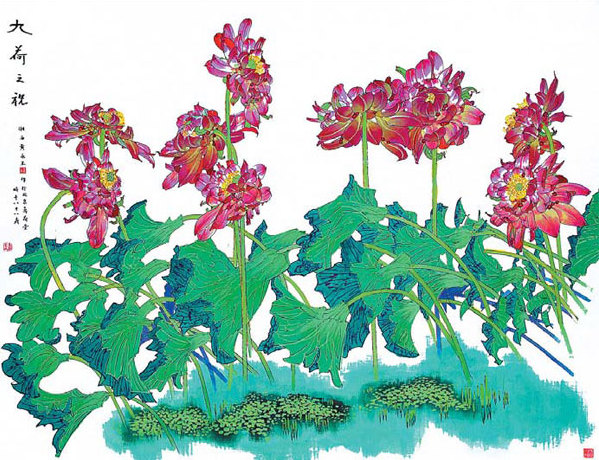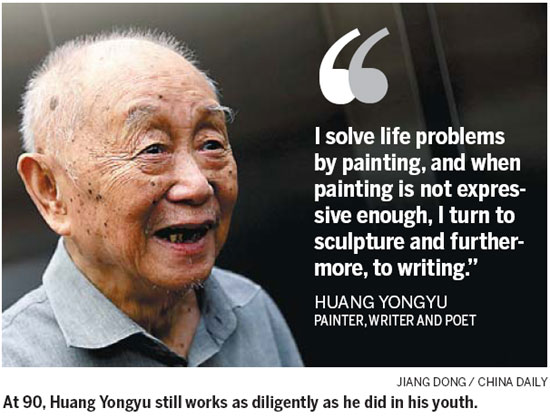

Things never came easy for celebrated artist Huang Yongyu, but hard work has made him a master even in old age, Lin Qi reports.
Asked to reflect on his decades-long art career, Huang Yongyu stresses every word of his reply: "It has been so toilsome."
His voice is imbued with uncommon seriousness, rather than the humor and wit he usually speaks with.
"I didn't receive adequate schooling, neither did I attend a regular art school. I acquired all my techniques by picking up a little bit from here and a little bit from there," says the accomplished painter, writer and poet.
"It's like an architecture that is not built on solid foundations and has a twisted appearance. It is a weak point but also has formed the distinctive style of my works."
Having just turned 90 in August, Huang still works as diligently as he did in his youth: He spends eight to nine hours a day writing and painting.
|
Lotus has been a recurring object in Huang Yongyu's works, such as Lotus and Red-crowned Cranes (top) in 2007 and Nine Lotuses (below) in 2011. Photos Provided to China Daily |

He is celebrating his 90th birthday with two publications, a complete collection of his literature and artworks, and the first part of his autobiography. He also has a retrospective exhibition currently on show at the National Museum of China.
At the same venue, he celebrated his 80th birthday with an art show that also toured to Hong Kong.
In addition to the landmark works that made him a household name, the exhibition has dedicated much more space to Huang's creations since 2004.
Huang wrote a calligraphic work in 2009 saying, "The world has grown up, and gosh, I'm getting old." The past decade, however, has witnessed his productiveness and versatility in oil painting, Chinese painting and calligraphy, sculpture, design and glasswork, which haven't withered away despite his aging.
He ranked ninth on this year's Hurun Art List and is among the most expensive Chinese artists alive. Nevertheless, the commercial success is far less enthralling for him than savoring the joy of completing a piece of art.
"Painting is a process which one should do to his heart's content," Huang says. "One should enjoy himself in any cultural activity. Even when writing a tragedy, one should feel satisfied."
He says because he has produced so many works, sometimes he will forget what he painted until he sees the piece on display. Thus, he says, he can't tell people which painting is the most representative of his oeuvre.
At the least, visitors to the ongoing exhibition should not miss two highlight works. One is an ink painting of lotuses that measures 3.67 meters in length and 1.44 meters in height, which Huang just finished a month before the opening.
In the painting Huang adopted baimiao, a technique with which the painter draws in simple ink lines and in no or light colors.
Lotus has been a recurring object in Huang's works. His childhood memories are full of the lotus pool at his maternal grandmother's home. He names his paradise, a Chinese-style manor in Beijing's suburb, Garden of Ten Thousand Lotuses. He says that lotus is quite a unique plant with its leaves, flowers and roots, which "bring many possibilities in composition and require different painting techniques".
Another work, a mural called Great Unity of Chinese People of Various Ethnic Groups, which Huang created in 1959, also deserves much attention, because it is one of the only two Chinese mural works of the 1950s left today.
On Tuesday, the first part of Huang's autobiography, titled A Wanderer over the Carefree Waters - Zhu Que City, was officially launched at the museum by People's Literature Publishing House. It gives a vivid portrait of his childhood in the scenic county of Fenghuang, Hunan province.
Huang associates the warmth and enthusiasm of his art with his early years in his hometown and his later experiences as a vagrant during chaotic times.
"Confucius said that 'I lived a humble life in childhood, thus I've acquired a lot of skills'. I'm also much more familiar with the lives of the underprivileged. I totally understand what they think and say. I paint, write and make things that most viewers feel attached to," Huang says.
He says the power of his works comes from his bravery and his positive attitude toward life.
"I'm doing my best to live a normal and peaceful life, even when it does not always go that smoothly. I solve life problems by painting, and when painting is not expressive enough, I turn to sculpture and furthermore, to writing."
Humor is another keynote that has made his artistic charm appreciated by more people.
He jokes that he was born not a serious man. "I'm not someone who will ponder over majestic questions such as the meaning of life as soon as he wakes up. The moment I get out of bed, I only think about how to write and paint.
"One can't enjoy life if he spends all day long thinking about the meaning of everything."
National Museum of China's director Lyu Zhangshen comments that Huang not only incorporates the mainstream of Chinese and Western cultures in his hierarchy of knowledge; he also expresses folk wisdom in his diversified creations.
Huang says he lives the day lying on the ground and smelling the odor of mud. "The benefit of being down-to-earth is one will not feel the pain of falling down off the peak."
Guang Jun, professor with the Central Academy of Fine Arts, says Huang has achieved so much because he has a good appetite for art and a heart of tolerance.
"He (Huang) puts the world on one end of a balancing board and himself on the other end. He has equipped himself with special wings, and is making great efforts to perfect his art. Little by little, he gains more weight and counters the world," Guang says.
Guang sees Huang as "an old buddy" as well as a role model:
"I may feel quite contented to play teeter board with him, but I can never lift up his side."
Huang is working on the second half of his autobiography, which will recollect his experiences in wartime. He says the book's third installment will be about the twists and turns of his life from 1949 to the "cultural revolution" (1966-76).
"I'm not sure whether I can live for another 10 years and finish the other two parts. Let time decide."
If you go
Exhibition of Huang Yongyu's Art to Celebrate His 90th Birthday
9 am-5 pm, no entrance after 4 pm, closed on Mondays, until Sept 16. National Museum of China, east of Tian'anmen Square, 16 East Chang'an Avenue, Beijing. 010-6511-6400.
